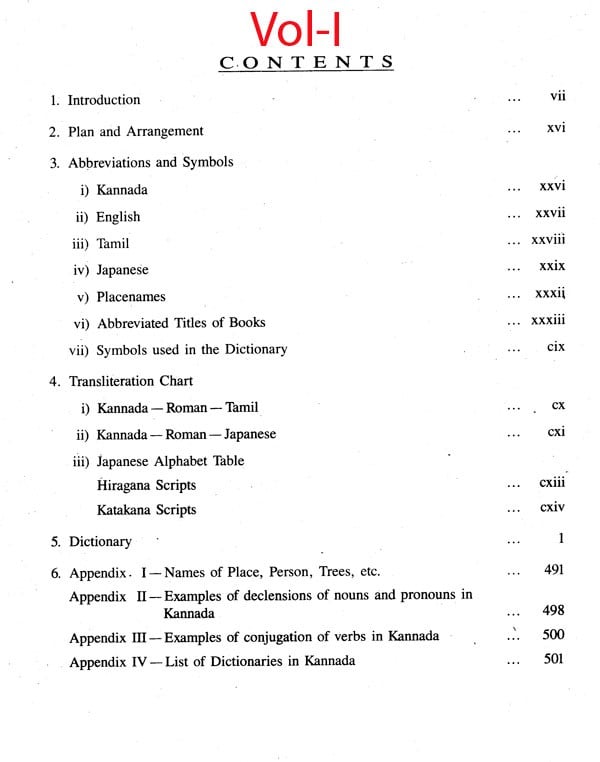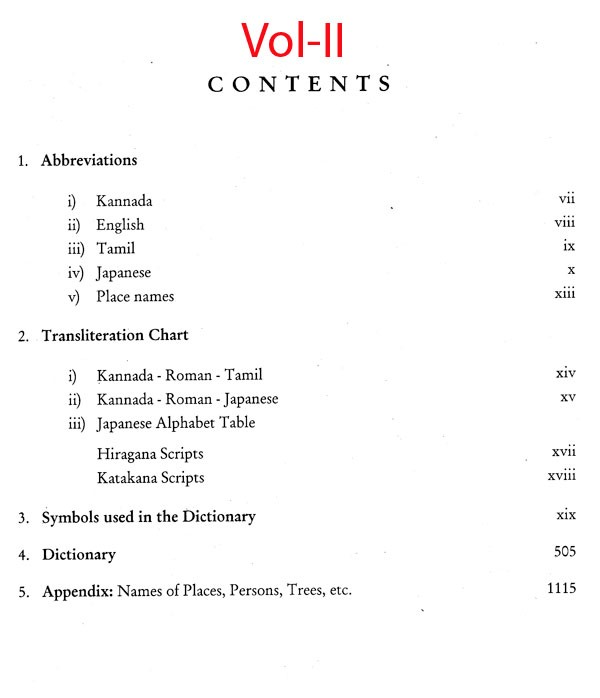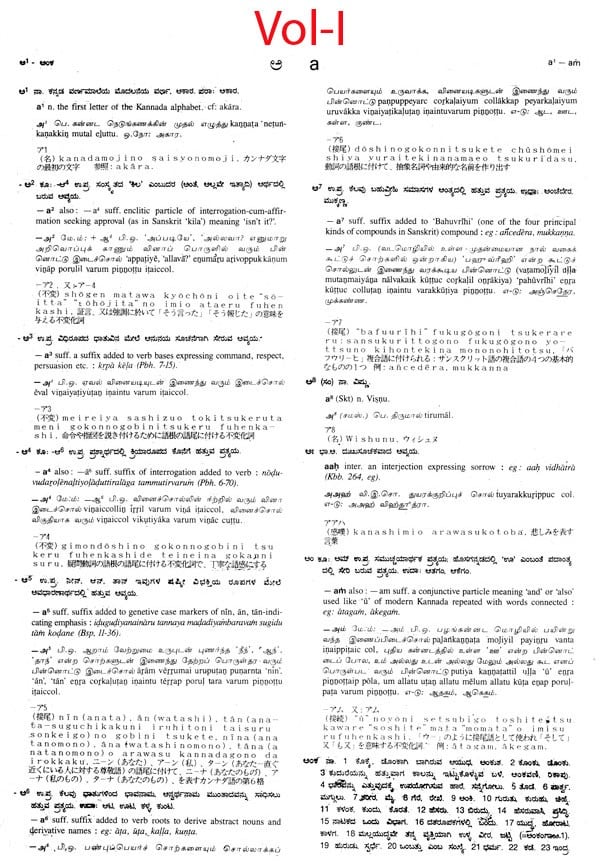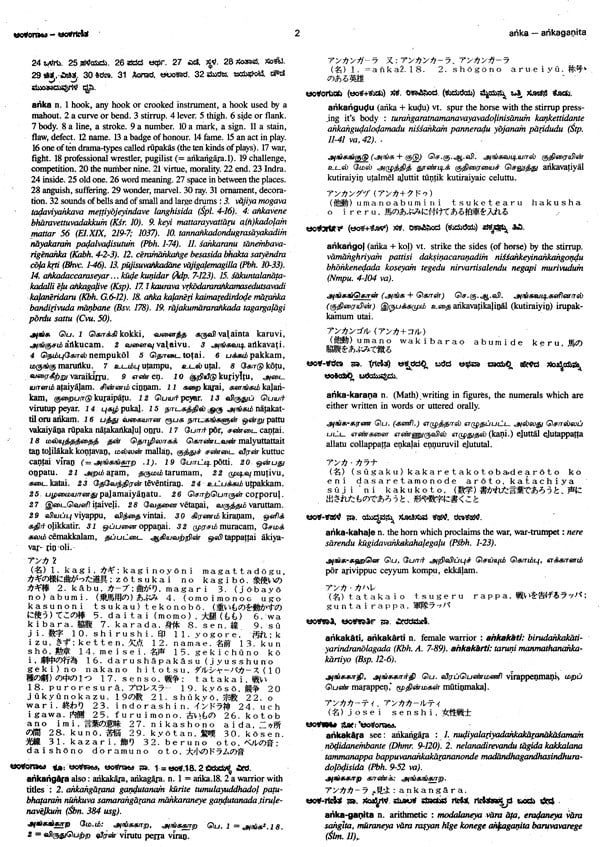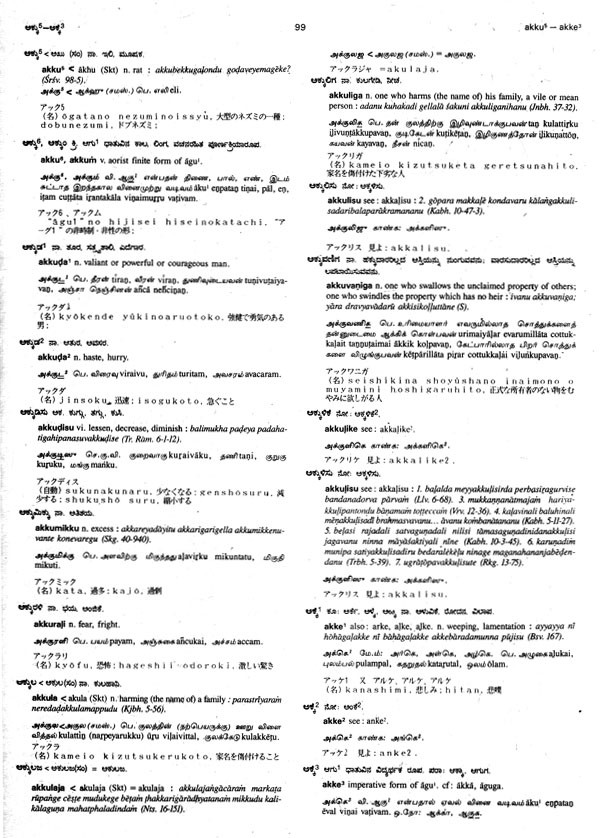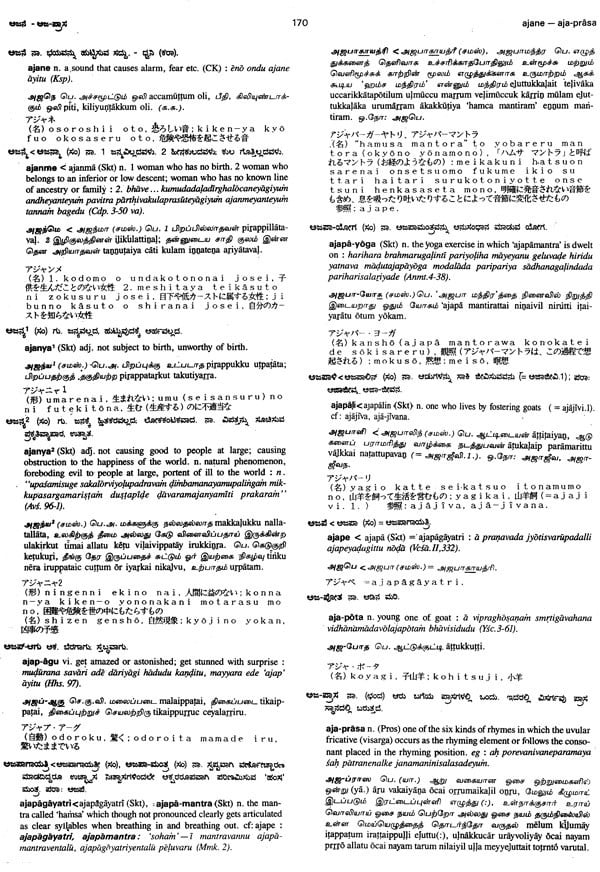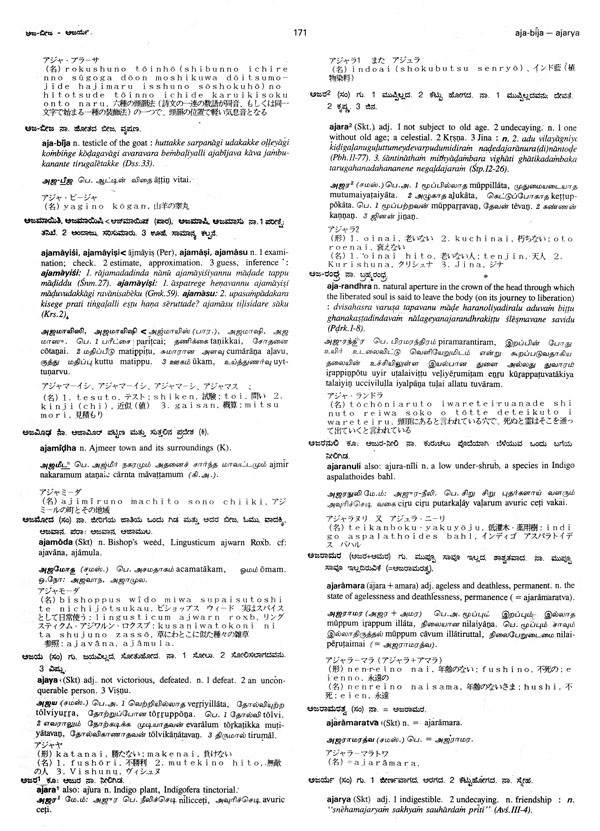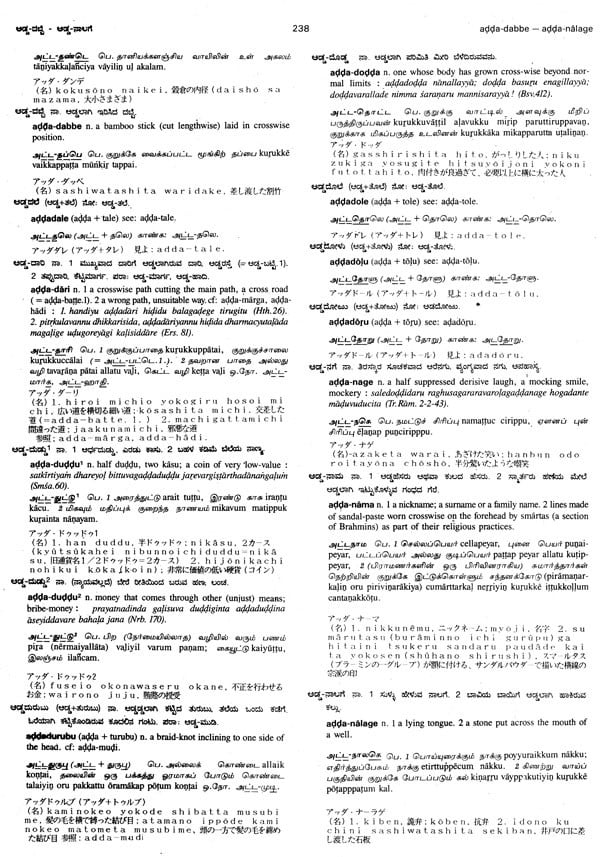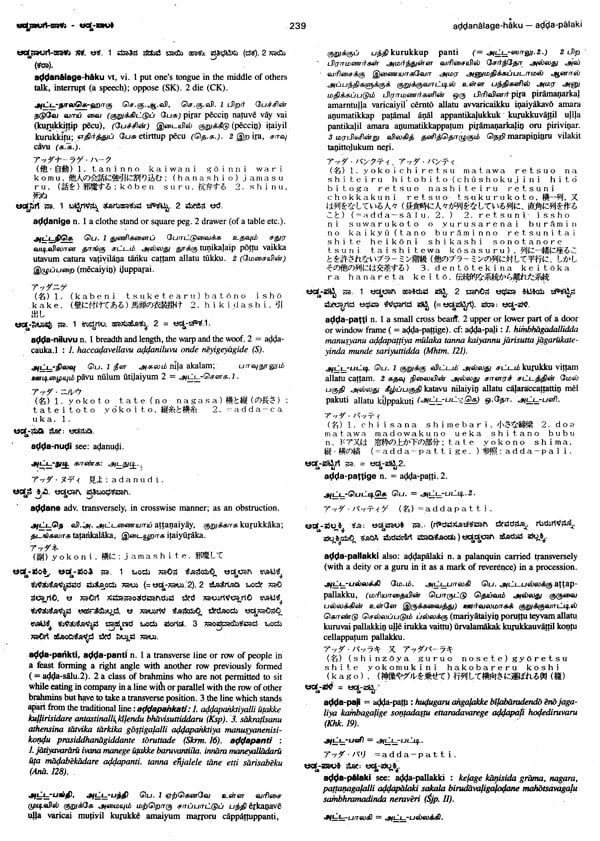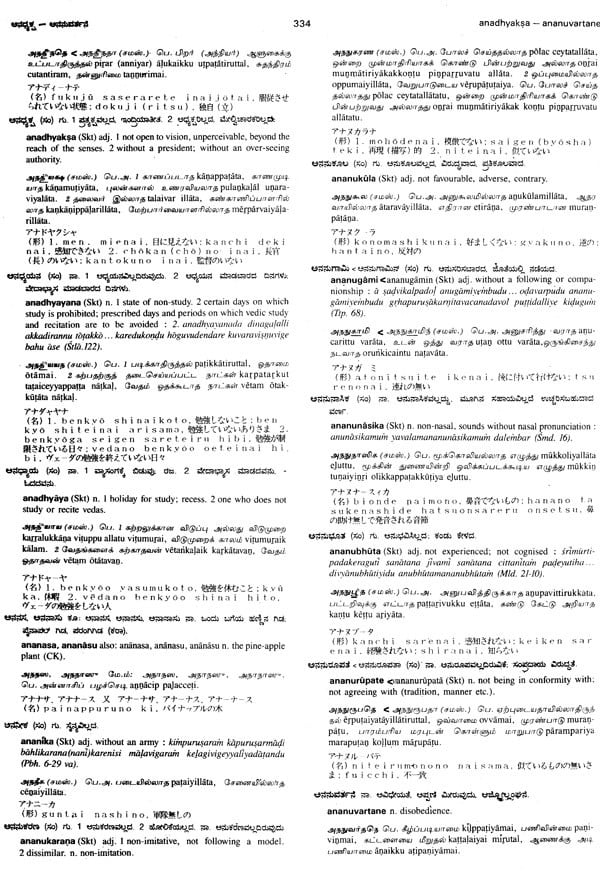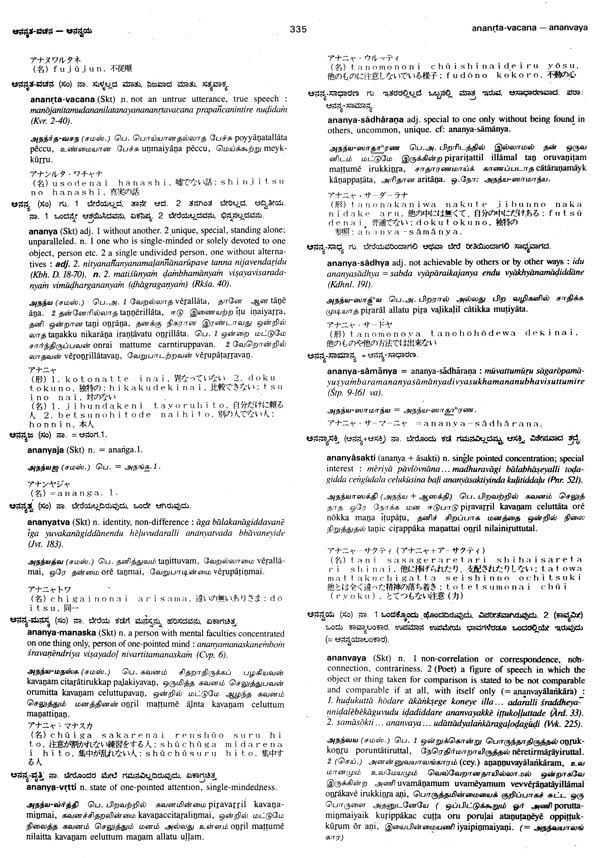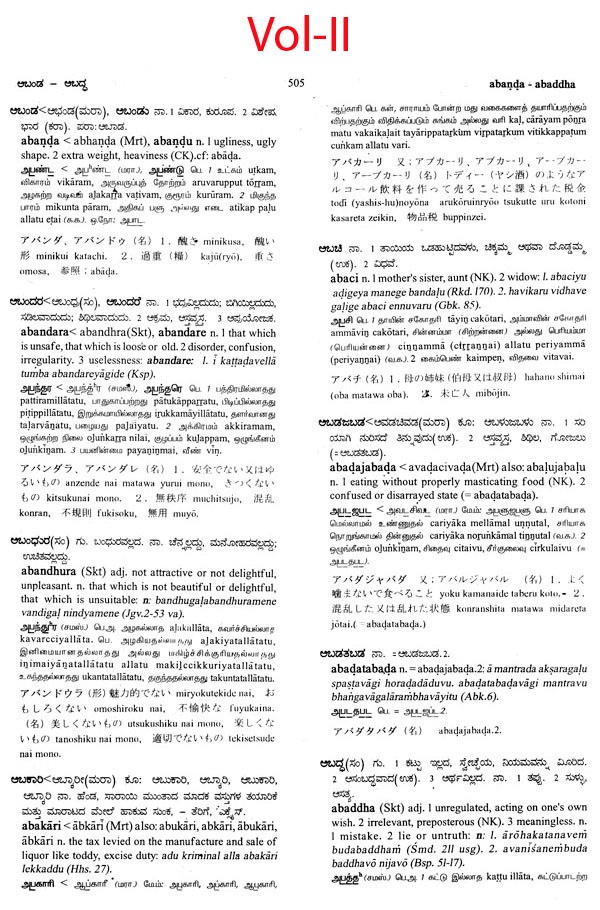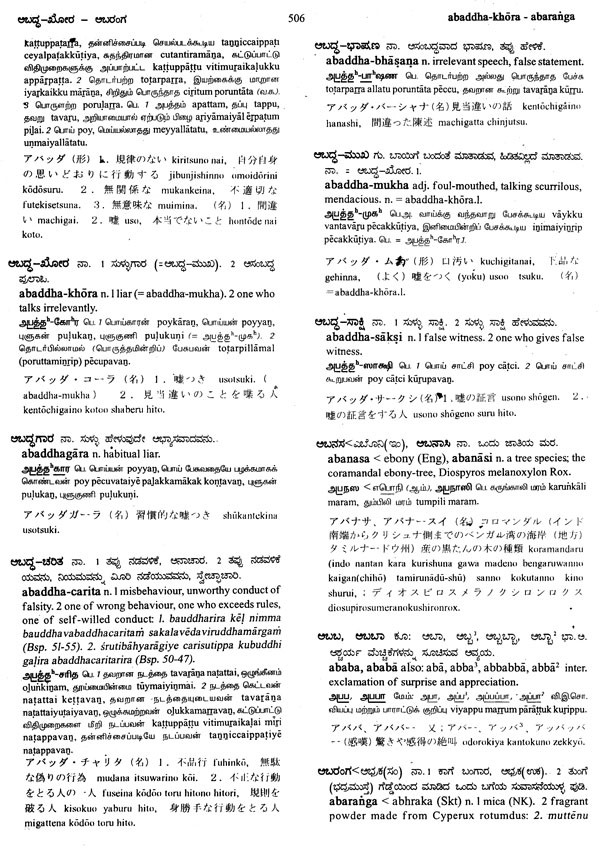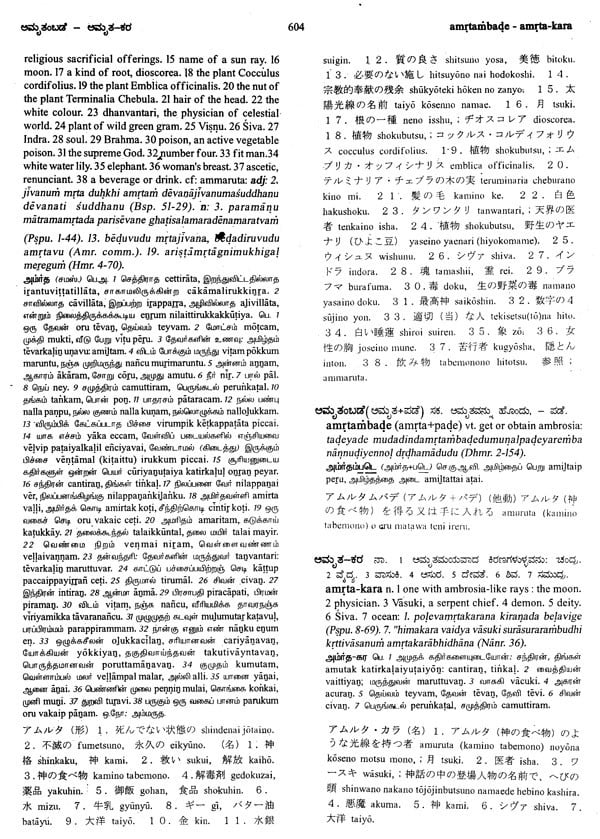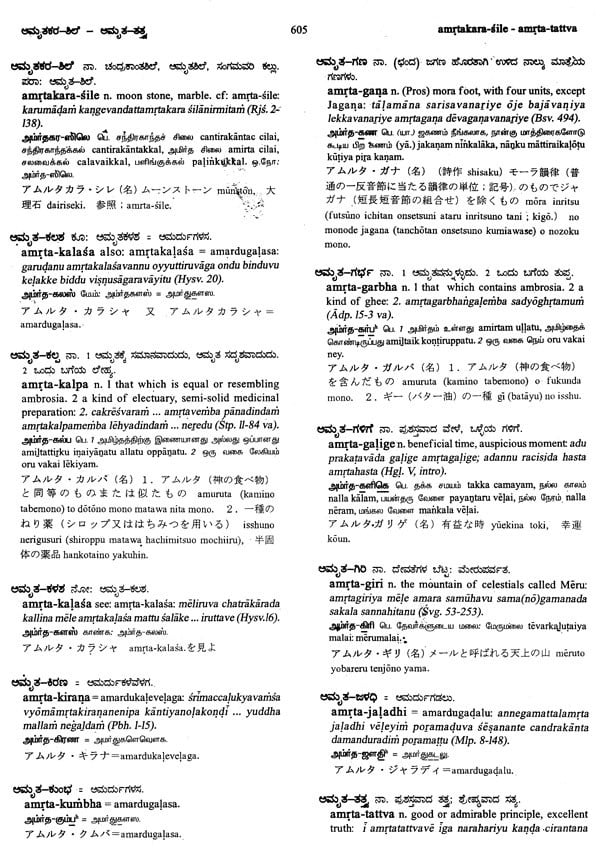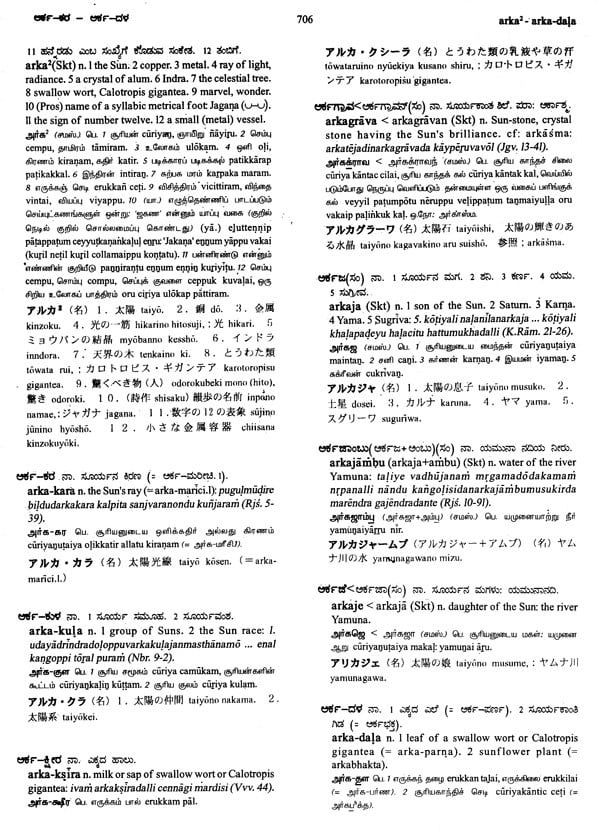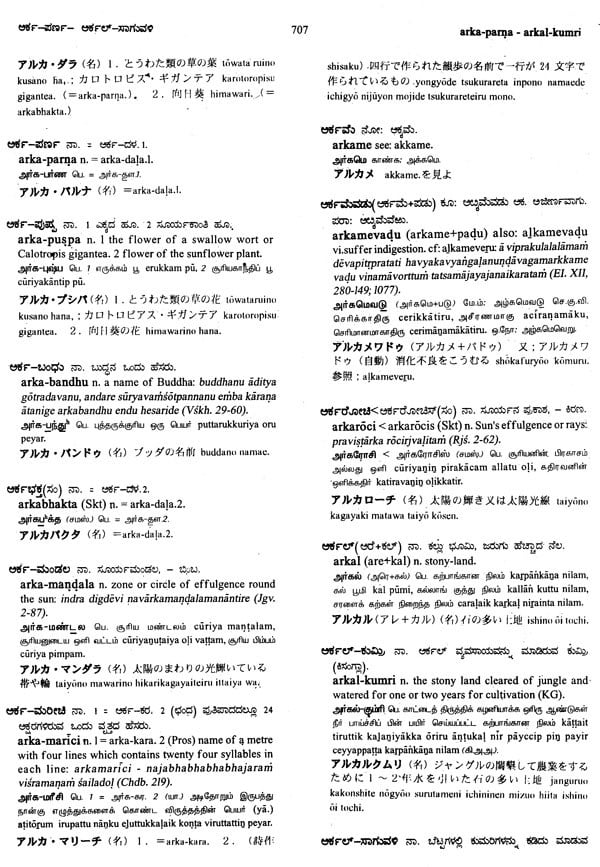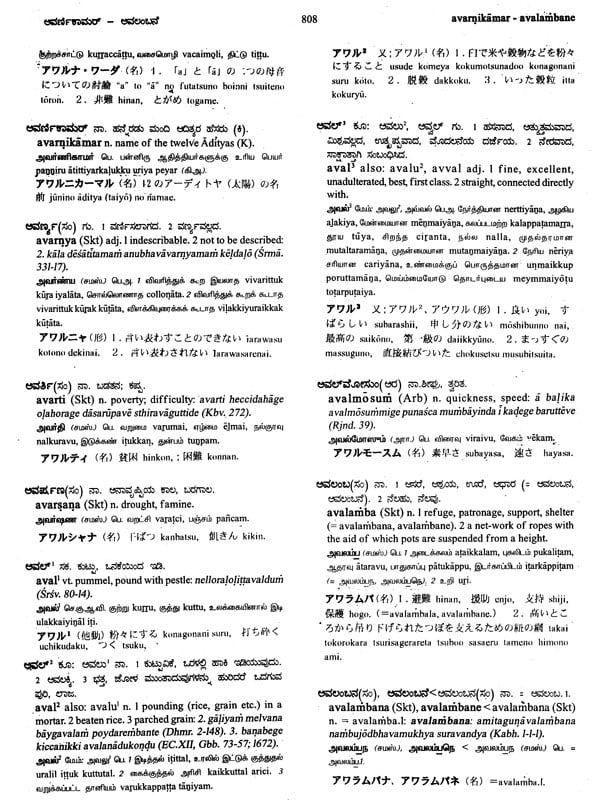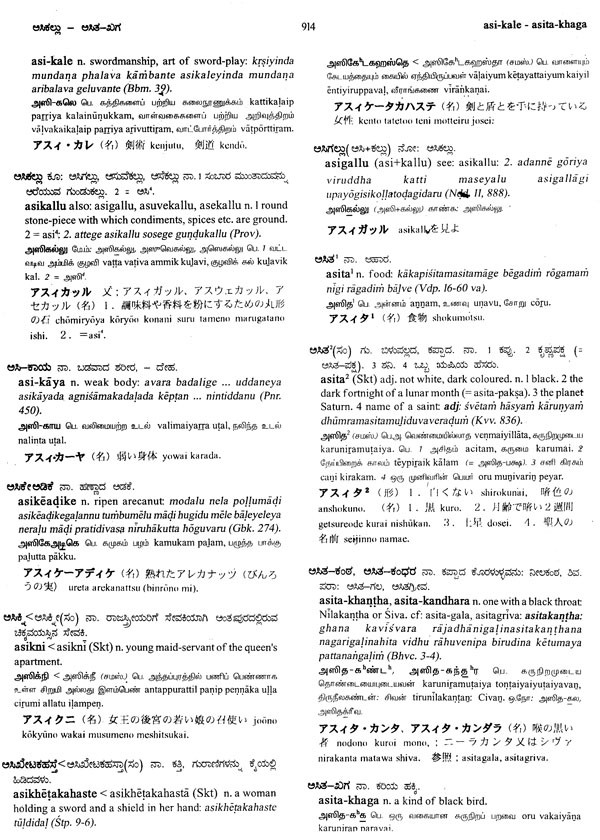
A Multilingual Dictionary of Kannada - English - Tamil - Japanese- An Old and Rare Book (Set Of 2 Volumes)
Book Specification
| Item Code: | NBZ684 |
| Author: | G. John Samuel and V. Gopalakrishna |
| Publisher: | Institute of Asian Studies, Chennai |
| Language: | Kannada, English, Tamil and Japanese Translations |
| Edition: | 1995 |
| Pages: | 1258 |
| Cover: | HARDCOVER |
| Other Details | 11.00 X 8.50 inch |
| Weight | 3.75 kg |
Book Description
Dr. Samuel Johnson, a literary giant and a formidable multilingual scholar of his days, brought out a dictionary in which he defines a lexicographer as a dictionary maker, a harmless drudge. Dr. Johnson who had strong personal likes and dislikes of men and matters brought them to bear in his lexicography as for instance when he gave the meaning for the word oatsas a foodgrain eaten by horses in England and human beings in Scotland. However, Dr. Johnson was also great and modest to admit his mistakes. When a lady pointed out to him that he had not given the exact and correct meaning for the word pastern, Dr. Johnson confessed that it was his ignorance that caused the error.
More than two centuries have elapsed since Dr. Johnson’s lexicographical effort, but even today the drudgery in dictionary making is very much there. Collection of all available words, their compilation, alphabetical arrangement, providing the various shades of relevant meanings and connotations, the necessary phonetic symbols and other indicators are all there in dictionary making involving laborious, painstaking work and meticulous checking and crosschecking by a team of learned scholars and linguists. If much drudgery is there in respect of a monolingual dictionary, the mindboggling effort in bringing out a multilingual dictionary can very well be imagined. It is pertinent in this context to note that, if wrong or incorrect meanings are provided in a present day dictionary, the lexicographers concerned cannot attribute the mistakes to their ignorance and get away with it as Dr. Johnson did because today readers, critics and reviewers do not take kindly to errors. Even Homer, if he were alive today, cannot simply nod his acceptance of his mistake, as he will have to face the rigours of critical censure. It is against the afore said background of dictionary making in general, this multilingual dictionary (Kannada-Kannada-English-Tamil-Japanese) is sought to be introduced here. It may be interesting to observe here that the challenge of lexicography that could confuse and rattle Dr. Samuel Johnson was taken up in its multilingual enormity by the Institute of Asian Studies with a dedicated band of scholars and linguists who spared no pains and left no stone unturned to prove equal to the formidable task.
Scope and Objectives
The Institute of Asian Studies, established as an international academic centre, has for its central objective, the promotion of interdisciplinary investigation of the literary and cultural facets of the Asian Countries. Preparation of reference materials such as encyclopaedias for different disciplines in humanities, multilingual dictionaries and catalogues, besides translation of classics from one language into another and into English constitute the prime layer of the academic activities in this institute. These reference materials form the basis upon which we carry out and continue the Institute’s academic projects like the cross-cultural studies of Asian arts and literature. Hence, compilation of multi-lingual dictionaries is an academic and intellectual necessity for this Institute, as also one of its seminal programmes.
Most of the South and South East Asian Countries had been under the political dominance of the European and American Countries for about the last two hundred years and consequently their cultures and concepts were very much influenced by western thinking with absolutely no interaction between themselves. Now that they are independent, the interaction between these neighbours has perforce increased on account of the knowledge explosion in technology, culture and literature. It may not be wrong to hypothesize that the twenty-first century may turn out to be an Asian century as against the 20th century which had been a Western one with a pronounced American impact. The affinity between the Asian countries in religion, culture, architecture, literature, etc. is greater than such a bond in the west. The quest to investigate this affinity, leading us to probe the literary and cultural universals between these countries is in a developing stage, and we have to equip ourselves properly to play an important role. In such a context, Asian language studies become important for which multilingual dictionaries of this sort are the one of the essential tools to learn the languages concerned. But we cannot forget the role of English in international gatherings. Hence, the justification to compile a dictionary of this sort. We have included Japanese language as another Asian language, two Dravidian languages, Kannada and Tamil and the international language English. This is only a starting model, on the experiences of which, we want to extend it to other Indian and Asian languages. This will be an ongoing project for the Institute Studies, Madras.
The Institute is planning to undertake translations of a number of Japanese classics into Indian languages and Indian classics into Japanese. Similarly there are proposals for translating other modern works pertaining to science and technology from Japanese into Indian languages. These translations will enable mutual flow of ideas from India to Japan and Japan to India. This will also help Indians to know more about the highest achievements attained by the people of Japan in the field of science and technology.
A number of young enterprising people of India want to learn Japanese. They want to interact with their counterparts in Japan and to do commercial activities with Japanese collaboration. The serious limitations for this smooth relationship is the linguistic barrier. Mutual translations will enable people to transcend the linguistic barriers and join together and expand their activities to create the new Asian Century. The present dictionary will provide equivalents for Japanese words and enable the Kannada speaking community as well as the Tamil speaking community to come closer to Japanese people.
The Multilingual Dictionary
This multilingual dictionary, the first of its kind for a Dravidian language is one of the projects launched by the Institute in fulfilling this objective. It is unique in the true sense of the term and its novelty need hardly be emphasized. This dictionary has Kannada for the source language, the other three being languages used for explication. The aim of this Dictionary is two fold; to present a complete picture of the lexical corpus in the Kannada language and to facilitate studies of the Kannada language and literature in a wider, comparative perspective. The need for such a dictionary of the Kannada language has been felt for long. The existing bilingual dictionaries in Kannada are demonstrably incomplete, prepared as they were about hundred years ago. Any living language like Kannada is necessarily dynamic and changes constantly. In consonance with the technological and scientific advancements and the changes that have occurred in the fields of medicine, industry, law, politics, international affairs and the like, the people of Karnataka, like others, have confronted the challenge of comprehending these developments and communicating them in their academic and professional discourses. Secondly, there is also the need to examine and record the changes taking place in the contemporary language as a result of the interaction between the native institutions, social and linguistic, and those in other parts of India and abroad. These developments and interactions do necessitate the inclusion of new lexical items into the existing vocabulary as also the recording of the new shades of meaning that some of the existing terms have acquired in course of time.
The project of this Institute represents the fulfilment of the demands today. A Dictionary Carnataca and English (1832) by the Rev. W. Reeve and its revised and enlarged version by Daniel Sanderson in 1858, and Kittel’s Kannada-English Dictionary of 1894 are inadequate, out-dated and unrepresentative of the rich literary and cultural tradition of Karnataka. The revised and enlarged edition of Kittel’s dictionary brought out by the University of Madras in 1968 has included only some additional lexical items to the original list of about 60,000 entries. The one serious draw back of this dictionary is that there is no indication of the status and functional labels of the headwords. It also contains many inaccuracies and misdirections of cross references. Again Kittel’s at present is inadequate not only because, during these ten decades the Kannada language, like any other modern languages, has traversed a long way, changing its course and contents as it were by the demands of the technological era, and also because it has not brought into its canvass the complete range of terms, conceptual and non-conceptual, that inform the classical, medieval and modern literature in Kannada. This fact is compulsively evident through a comparison of this dictionary with the Kannada Nighantu of the Kannada Sahitya Parishat. There is thus a compelling and immediate need to update the existing dictionaries and to bring out one that not only fulfils the requirements of the changed milieu, but also conforms to the advanced lexicographical principles and techniques. Again, given the linguistic and social circumstances obtaining in our country, and the need for interaction and intercreativity amongst the peoples of this multilingual land, one needs not emphasize the importance of bilingual and multilingual dictionaries that are as much complete and comprehensive as the monolingual Nighantus like the Kannada Nighantu mentioned above.
Apart from serving as a first class lexical guide to the whole body of Kannada learning and the literary interests of Kannada, in other parts of India and abroad as much as in Karnataka, and facilitating cross-cultural studies with English, Tamil and Japanese, it could contribute in establishing linguistic and cultural contacts.
The salient features of the dictionary are mentioned below :
1. This is the first volume of the proposed six volumes of the Multilingual Dictionary estimated to cover about one lakh Kannada lexical items. There will be a separate volume for Index to include to glossed used in the target languages to facilitate the users locate corresponding lexical items. The glossed will be arranged alphabetically in all the three target languages. This index volume will help the Japanese people to identify equivalents for Japanese words in the other three languages viz. Kannada, English and Tamil.
2. The effort is to update the entire range of the Kannada lexical corpus.
3. Unlike earlier bilingual dictionaries, the person one is a multilingual one for four languages. The glosses of the lexical items are made more informative and useful by giving the grammatical category, vocabulary register, references and citations against the lexical items conforming to modern lexicographical techniques.
4. Errors, omissions or commissions in giving the meanings, descrepancies in grammatical notes and deficiencies in other areas noticed in earlier dictionaries, have been rectified with care.
5. Explanations against entries from various disciplines like religion, folk arts, astrology and fine arts, terms relating to cultural items like costumes, crafts are also given with their values and social relevance. Lexical items from literature, language, science and humanities, etc. receive detailed discussions of their usages and important information not available in earlier dictionaries is incorporated.
6. Dialectal and regional lexemes, words of non-naïve origin, etc. have all been covered in this work. It may be stated, without immodesty, that this work renders ample justice to all the etymological, orthographic, phonetic and grammatical aspects of lexicography.
KANNADA : ANTIQUITY OF LANGUAGE AND DEVELOPMENT
Kannada, the source language of this multilingual dictionary, is one of the languages recognised by the India constitution. Linguistically, Kannada is one of the major languages of South Dravidian family of languages. Nearly 20 million people of Karnataka speak this language as their mother tongue besides it being the language of administration and medium of instruction in the majority of schools and colleges of Karnataka. This language also occupies an important position as a minority language in the adjoining states of Andhra Pradesh, Kerala, Maharashtra and Tamil Nadu as well as in a number of metropolitan cities of India.
Though there are evidences to prove the existence of Kannada land and its language in the early Vedic period and later in the Puranas, the recorded evidence now available is the Halmidi inscription (5th cent. AD) where there is a clear indication of the developed stage of the language. It is clear from this inscription that by that time the language had matured into a literary medium. The first recorded evidence of the Kannada script is also available from the same inscription. Kavirajamarga, a treatise on rhetorics, Vaddaradhane, the first extant prose composition, and Adipurana, the first epic available in Kannada, were available by the 9th and 10th centuries. The references made by these authors in their works to a number of earlier poets and authors, testify to the fact the language had not only attained a well developed stage but also had a rich literary tradition even before the beginning of 9th century. On the basis of these evidences scholars infer that the history of Kannada literature goes back to at least over a millennium and a half.
Kannada language has passed through many stages of development in the last two milleni. Social, political and geographical division have brought in a lot of changes in the structure as well as in the usage of the language. In addition to these reasons the external influence through English language has enriched the Kannada language. When the medium of instruction became English at the higher levels of education, various new branches of knowledge began to develop in Kannada resulting in a lot of changes in the usage of the language. Hybrid forms, translated equivalents, direct borrowings and syntactical influence can be clearly noticed in Modern Kannada writing as well as in spoken Kannada. Prior to its contact with English, it was influenced only by Sanskrit and Prakrit but limited to the borrowing of lexical items.
The development of Kannada language could be traced approximately under four stages over a period of two thousand years. The language and grammatical forms available in some of the available inscriptions especially upto 750 AD testify earlier stages of Kannada language. Some scholars designate this stage as Primitive Old Kannada, Early Old Kannada, Pre-old Kannada, etc. Kannada language of this stage bears a closer affinity to Tamil. Some of these scholars try to trace out the Proto language in this stage when Kannada and Tamil were mere dialects of a single language. The language used between 850 AD and 1200 AD as Old Kannada and that from 13th century to 17th century is Medieval Kannada. NewKannada (Modern Kannada) is the language is use thereafter. This periodization is, however, mainly based on the literary works available and as for the spoken forms, no authentic data are available except a few phrases, idioms and lexical items found in the literary compositions of the respective periods.
Geographical and political factors in addition to the influence from other languages have resulted in the development of at least four regional major dialects, ie. Mysore Kannada, Mangalore Kannada, Dharwad Kannada and Gulbarga Kannada.
DICTIONARIES IN KANNADA
The earliest extant Kannada dictionary Rannakanda was compiled in the 10th century AD. In the beginning, most of the dictionaries were composed in verse on the pattern of Sanskrit dictionaries, especially of the Amarakosa model. It was so in almost all Indian languages, since it was easy to memorize the verses. These were mostly monolingual dictionaries and the main objective of such compilations was to give meanings for so-called difficult words found in literary compositions. Therefore, the number of lexical items in them was limited. Later, when these complications in verse form also became difficult for comprehension due to the process of language change, a considerable number of commentaries written by scholars began to appear, giving meanings with explanations in simple language.
These dictionaries adapted varied poetical metres in their compositions and some of them followed the method of classification of vocabulary on the basis of themes following the model of Amarakosa.
The Christian missionaries who came to Karnataka with the aim of spreading Christianity began to compile compendious bilingual dictionaries rich in contents, modern in utility and fairly based on lexicographical methodology. A gradual improvement in the methodology followed by these compilers becomes evident in the brief history of the Kannada lexicography given below.
**Contents and Sample Pages**
